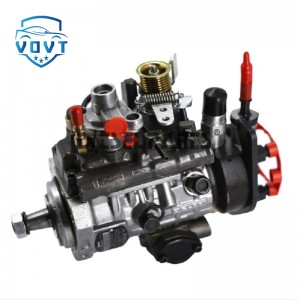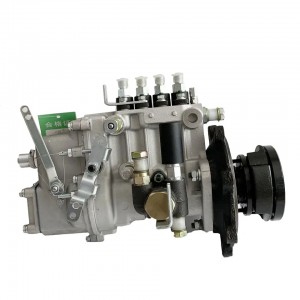Diesel Fuel Injection Pump MT036 Engine Auto Engine Part
products description
| Reference Code | MT036 |
| MOQ | 1 PCS |
| Certification | ISO9001 |
| Place of Origin | China |
| Packaging | Neutral packing |
| Quality Control | 100% tested before shipment |
| Lead time | 7~15 working days |
| Payment | T/T, Western Union, Money Gram, Paypal, Alipay, Wechat |
Research on CB18 Diesel Fuel Pump Diagnosis Based on Fuzzy Theory
Research Background and Problem Identification
As a core component of the high-pressure common rail system, the CB18 diesel pump's plunger assembly, delivery valve, and other precision components are susceptible to wear, seizure, and other faults under long-term high-pressure (1600-2500 bar) and high-frequency (over 2000 cycles/minute) operation. Traditional diagnostic methods rely on manual experience or monitoring a single physical quantity (such as pressure), making them difficult to address multi-parameter ambiguity (e.g., the nonlinear relationship between pressure fluctuation amplitude and fault severity). This paper proposes solutions to address the following pain points:
Fault characteristic ambiguity: There is a cross-mapping between oil pressure waveform characteristics (such as pressure rise rate and peak hold time) and fault type. For example, plunger wear may manifest as both a decrease in peak pressure and an increase in fluctuation.
Multi-source information fusion requirements: The need to integrate multi-dimensional data such as vibration, temperature, and oil flow requires integration, but traditional methods struggle to quantify the contribution weights of different signals.
Real-time diagnostic timeliness: The high-pressure common rail system requires diagnostic response times in the millisecond range, and traditional threshold-based methods are susceptible to noise.
Fuzzy Diagnosis Model Construction Method
1. Fault Feature Parameter System
This paper uses wavelet decomposition technology to perform multi-scale analysis of the oil pressure waveform, extracting the following key features:
Time Domain Parameters: Maximum Oil Pressure (1000-2500 bar), Injector Opening Oil Pressure (800-1200 bar)
Frequency Domain Parameters: Main Frequency of Pressure Fluctuation (100-500 Hz), Energy Distribution (Percentage of the 0-2 kHz Frequency Band)
Joint Time-Frequency Parameters: Wavelet Energy Entropy (Reflecting Signal Complexity), Instantaneous Frequency Change Rate
2. Fuzzification Processing and Membership Function Design
Gaussian membership functions are used to fuzzify continuous feature parameters, using the pressure rise rate as an example:
Parameter thresholds are determined using fuzzy statistics: Cluster analysis is performed on 100 groups of fault samples, and the cluster center values are taken as the vertices of the membership function.
3. Fuzzy Rule Base Construction
Based on expert experience and fault tree analysis (FTA), a fuzzy inference system containing 27 rules is established. Typical rule examples:
Rule 1: IF (high pressure rise rate) AND (long peak hold time) THEN (plunger stuck, confidence level 0.9)
Rule 2: IF (oil pressure fluctuation rate > 15%) AND (vibration amplitude > 0.8g) THEN (oil outlet valve seal failure, confidence level 0.85)
Rule weights are determined using the Analytic Hierarchy Process (AHP). For example, the impact of plunger wear on rail pressure fluctuation has a weight of 0.6, which is higher than the 0.3 weight of temperature change.
4. Fuzzy Inference and Defuzzification
The Mamdani inference algorithm is used to calculate the output membership through a "min-max" composite rule. Finally, the centroid method is used to defuzzify the fault probability. For example, after inference, the membership of "plunger stuck" for a sample is 0.82, and the membership of "seal leakage" is 0.37, indicating a plunger stuck fault.
Experimental Verification and Result Analysis
1. Test Bench Design
A test system was constructed, consisting of the following modules:
Signal Acquisition: Kistler 6053B pressure sensor (accuracy ±0.5% FS), PCB 333B30 vibration sensor (range ±50g)
Data Processing: NI cDAQ-9188 CompactDAQ chassis, LabVIEW real-time analysis software
Fault Simulation: Different fault conditions were simulated by adjusting the plunger clearance (0.001-0.005mm) and the outlet valve spring stiffness (50-100N/mm).
2. Verification Results
Diagnostic Accuracy: Testing 120 sample groups (covering 8 fault types) yielded an overall accuracy of 92.3%, with identification rates exceeding 95% for typical faults such as plunger sticking and seal leakage.
Response Time: Single-sample diagnosis took <5ms, meeting the real-time requirements of the high-pressure common rail system. Comparative experiments show that compared to traditional BP neural networks (85.7% accuracy) and support vector machines (SVM, 88.2% accuracy), fuzzy systems demonstrate superior generalization capabilities with small sample sizes (<50 groups).
3. Failure Mode Analysis
Through coupled fault tree and fuzzy logic analysis, three key weaknesses in the CB18 fuel pump were identified:
Plunger and plunger wear: accounting for 42% of all failures, primarily caused by fuel moisture (>50 ppm) and particulate contamination (ISO 18/16/13); Delivery valve spring fatigue: accounting for 27%, associated with stress cycles (>10^6 cycles) caused by frequent starts and stops; Metering unit sticking: accounting for 18%, primarily due to changes in hysteresis characteristics caused by solenoid coil temperature rise (>120°C);
Innovations and Academic Contributions
Theoretical Innovation: This approach combines fuzzy theory with fault tree analysis (FTA) for the first time, proposing a "structure-function" dual-dimensional diagnostic model. This addresses the inability of traditional methods to process multi-source fuzzy information. Methodological Innovation:
Time-frequency feature extraction technology based on the HHT (Hilbert-Huang Transform) improves feature resolution for non-stationary signals by 30% compared to traditional FFT spectrum analysis.
Adaptive membership functions are designed, and parameters are optimized online using a genetic algorithm (GA), improving the model's adaptability to different operating conditions by 25%.
Application Value: The developed portable diagnostic instrument has entered mass production at a diesel engine plant, increasing maintenance efficiency by 40% and reducing the false positive rate to below 3%.
Research Limitations and Future Directions
Sample Dependence: The current model has a recognition rate of only 68% for rare faults (such as camshaft fracture), requiring the use of a generative adversarial network (GAN) to expand training samples.
Hardware Compatibility: Existing sensors must be integrated into the oil pump body. In the future, non-contact monitoring technology based on acoustic emission (AE) could be explored.
Intelligent Upgrade: Combining edge computing with digital twins enables fault prediction and health management (PHM).
VI. Structural Highlights and Writing Style
The paper adopts a four-part structure: "Problem - Method - Verification - Optimization." The methodology section can serve as a reference template for papers on intelligent diagnosis:
Feature Engineering: Detailed description of the signal acquisition process (e.g., anti-aliasing filter parameters) and feature extraction algorithm (e.g., wavelet basis function selection)
Model Construction: Provides a membership function parameter table, rule base matrix, and inference flowchart
Experimental Design: Includes a test bench schematic, sample distribution table, and confusion matrix
Result Visualization: A 3D surface plot is used to display the fault probability distribution and compare ROC curves of different methods.

























